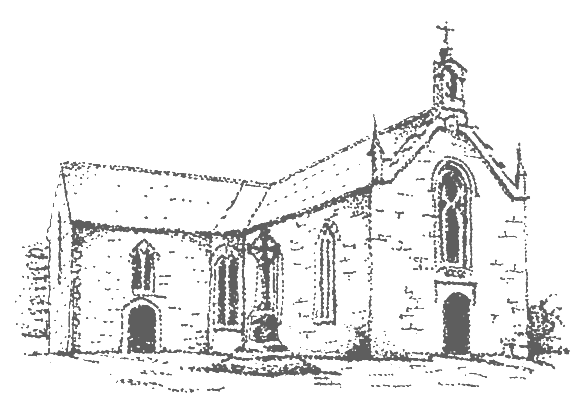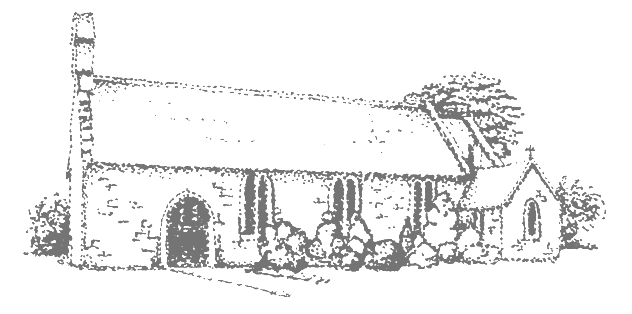The Graves in St. Mary’s Church, Askeaton
Fr. Edward Cussen was Parish Priest of Askeaton and Ballysteen from 1837 to 1860. It is he who was responsible for having the present church of St. Mary built in Askeaton, which was completed in 1851. It probably was he who also initiated the construction of the church of St. Patrick in Ballysteen (completed in 1861). Fr. Cussen ministered in the parish at a very sad and turbulent period, attending to and comforting those who died during the Great Famine. In 1847 at the height of that famine the previous parish church in the grounds of the Franciscan Abbey was burnt. On New Year’s Eve, 1848/’49, his young curate, Fr. James McDonnell, was returning from a sick call on Aughinish Island. The night was pitch dark and, disembarking from the boat on the quay, he lost his footing and was drowned in the River Deel. Fr. Cussen had been curate in Newcastle West previous to his appointment to Askeaton and we have in the church a silver chalice presented to him with the following inscription, ‘The Gift of the Parishioners of Newcastle to the Revd. EDWARD CUSSEN 1833’. When Fr. Cussen died he was buried in Askeaton Church under the main aisle.
Fr. Cussen was succeeded by Fr. James Raleigh who had been Parish Priest in Donaghmore, but he was appointed P.P. of Rathkeale in 1863. He, in turn, was succeeded by Fr. James Hickey, who died in 1871. Fr. Hickey was also interred under the main aisle of Askeaton Church.
The graves of Fr. Cussen and Fr. Hickey were overlaid with quite a striking variety of tiles. The tiles on the graves are russet-coloured (officially termed, tessellated red brick). The inscriptions are on inlaid black tiles. A pattern of red, black and beige tiles surrounds the graves. As the tiles covering both graves are similar in every way they must both have been laid there after the death of Fr. Hickey. This may well have been during the time of Fr. Hickey’s successor, Fr. Daniel O Connor, who remained as P.P. until 1886.
When Fr. Tom Kirby was Parish Priest he undertook to have Askeaton Church adapted to suit the new liturgy promulgated by the Second Vatican Council. This adaptation was carried out in 1977 and, while it was completed with great taste and in a way that befitted the new liturgy, it is also true to say that the change was not welcomed by everyone in the parish. The main issues for some people were the removal of the marble high altar and the marble altar rails that divided the sanctuary from the main body of the church. The gallery over the main door was also removed to provide more light in the church and to allow for a clearer view of the partly stained-glass window. Another regret that people had was the fact that the two graves in the church were covered over in concrete, surmounted by a carpet, and were no longer visible.
In 2001 in preparation for the 150th anniversary of the church Maurice Fitzgerald managed to locate the graves. All we had to go on was a black and white photograph, taken from the then main gallery during a wedding ceremony. To his great credit Maurice found the cross that marks the head of one of the graves and he opened up a narrow section along the length of the grave for a few feet. It was the grave of Fr. Cussen. Thankfully, aero board had been placed over the tiles before the concrete was laid on them. However, the tiles were now about four inches below the level of the current floor. Given the pressure of time and the problem of managing the four inch differential we could do nothing but re-cover with aero board and concrete the section of the tiles that been exposed, with the intention of returning to the project at a future date. Fortunately, we did take some photographs and some measurements of the exact position of the cross in relation to the altar step and the walls of the church.
Over several years I often had a discussion with various members of the Pastoral Council and parishioners as to what could be done. Because of the four-inch drop between the present floor and the tiles there didn’t seem to be any solution. We had thought of a plaque on the wall but it never seemed to be adequate. So, for several years, as the seanachaí says, ‘Things rested so’.
Then, a few years ago a particular parishioner became very insistent that something should be done to mark the graves, even if it were only a plaque on the wall. I brought it to the Pastoral Council and it was decided to look at what other parishes had done. The result was that a plaque on the wall or, perhaps better, a plaque on the ground or on the altar step would be the best solution. The decision had almost been made when, fortunately, Garry O Connor of Churchtown Memorials was doing some work for us and when it was mentioned to him he responded that it was possible to get a strengthened, non-slip floor glass. He made some enquiries for us and gave a rough estimate of the cost. Both the Pastoral Council and the Finance Committee agreed that it was worth going ahead with the excavation of the floor and the insertion of the glass.
Garry put me in touch with John Shiels of Ardagh and Bill Conroy of Newbridge, who both agreed to undertake the difficult task. We were blessed to have the expertise of all three men, who displayed a fascinating range of nous and skills as the work progressed. The crucial stage of the excavation took place over two long days, on 27th and 28th of November 2019. We now have recorded that with the logo on the limestone surrounds, Ath-léirithe 28-11-2019.
Erecting a tent over the section of the aisle in question to help contain the dust, John and Bill found the cross at the head of Fr. Cussen’s grave exactly where the measurements taken in 2001 had indicated. Having excavated that grave the next question was whether Fr. Hickey’s grave was above or below that of Fr. Cussen’s in the aisle. Taking an educated guess we decided to try above and fortunately that grave began to emerge. The aero board had protected the tiles from the concrete but there still was quite an amount of cement attached to them. As John said, ‘The church was a work-site before the aero board was put down’, so it was inevitable that that would have had some impact on the tiles. Each letter of the inscriptions was transcribed on a single black tile. Two of the tiles were missing and we wondered whether we should leave it so or get them replaced. We settled on the latter. The inscriptions on the graves run as follows:
BENEATH LIE
(TH)E REMAINS
OF THE REVD
JAS HICKEY
THE RESPECTED
P P OF ASKEATON
AND
BALLYSTEEN
R I P
BENEATH LIE
THE REMAINS
OF THE REVD
EDWARD CUSSEN
THE RESPECTED
P P OF ASKEATON
AND
BALLYSTEEN
R I P
The one surprise is that there are no dates mentioned.
There was a delay in the delivery of the glass from its manufacturers, with the result that it wasn’t put in place until 27thJanuary 2020. That was another delicate and difficult task. And here we encountered a disappointment. The ‘non-slip’ element of the glass was effected through sand-blasting grains of limestone onto the glass in small circles, which made the inscriptions less visible than we would have liked. We have had many experts looking at this to see if we can do anything about it but, to date, we haven’t found a solution.
There is an interesting theory as to where the tiles may have come from, proposed by Bill in particular. It appears that there was a landlord called, Dixon, who lived in Creeves. He owned 14,000 acres of land. He had a quarry of red clay opened at Clounlehard, which flourished from the 1820s to around 1960. From this were manufactured red bricks. Kilteery Pier was built for the purpose of exporting them. The red-brick houses in O Connell Avenue in Limerick were built with these bricks. (This also put me thinking about the Parochial House. It is constructed with red brick and was completed in 1911, so could the bricks have come from the quarry in Clounlehard?) At any rate Bill thinks it likely that the tiles on the graves in the church came from Clounlehard. If so, it is a nice rounding-off of our story of the re-discovery of the graves in Askeaton Church.
As a final comment, we all believe that it was a task worth undertaking and any parishioner who has seen the graves has been happy with the fact that they are once again visible.
Fr. Seán Ó Longaigh

